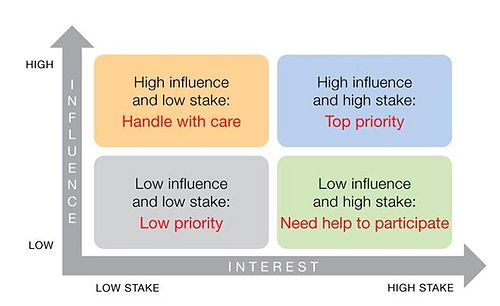Toolbox
| Line 12: | Line 12: | ||
In addition, improving stakeholder affinity, that depends on power and interest, is a crucial point to take into account. Some stakeholders have more influence than others and it is mandatory to recognize this by means of stakeholder mapping as well. A matrix where each and every stakeholder is classified is what the method suggests [2]: | In addition, improving stakeholder affinity, that depends on power and interest, is a crucial point to take into account. Some stakeholders have more influence than others and it is mandatory to recognize this by means of stakeholder mapping as well. A matrix where each and every stakeholder is classified is what the method suggests [2]: | ||
| − | [[File:aaa.jpg|thumb|Stakeholder map ''Strategyzer.com'' <ref name="International Atomic Energy Agency"/>|500px]] | + | [[File:aaa.jpg|thumb|Stakeholder map ''Strategyzer.com'' <ref name="International Atomic Energy Agency [5]"/>|500px]] |
| Line 32: | Line 32: | ||
[1] http://wiki.doing-projects.org/index.php/Stakeholder_Management | [1] http://wiki.doing-projects.org/index.php/Stakeholder_Management | ||
[2] https://www.stakeholdermap.com/ | [2] https://www.stakeholdermap.com/ | ||
| − | [3] https://www.researchgate.net/figure/Typology-of-Stakeholder-Integration | + | [3] https://www.researchgate.net/figure/Typology-of-Stakeholder-Integration |
| + | Mechanisms_fig1_254800916 | ||
[4] https://www.investopedia.com/terms/s/stakeholder.asp | [4] https://www.investopedia.com/terms/s/stakeholder.asp | ||
| + | [5] https://www.iaea.org/resources/nuclear-communicators-toolbox/methods/planning/stakeholder- | ||
| + | analysis | ||
Revision as of 13:31, 21 February 2020
Buenos días
Contents |
People
Stakeholder map
Stakeholders are people interested in a company or a project, and can be affected directly or indirectly from it. In every engineering project it is necessary to manage properly the people involved, such as investors, suppliers, clients and line managers, because each of them has a distinct interest in the completion of the same. It is very important to do this after identifying the purpose of the project, otherwise a wrong understanding of stakeholders can occur [1]. A stakeholder map is the ideal tool to accomplish this and have every part involved internally and externally in the project satisfied. All stakeholders are not the same, they have different influences and interest surrounding the project. Commonly, stakeholders are differentiated or classified depending on three criteria: power, legitimacy and urgency [2]. Stakeholders mapping can lead to many results and outcomes, and it is important to focus the outcomes to achieve a proper stakeholder engagement at all levels. In addition, improving stakeholder affinity, that depends on power and interest, is a crucial point to take into account. Some stakeholders have more influence than others and it is mandatory to recognize this by means of stakeholder mapping as well. A matrix where each and every stakeholder is classified is what the method suggests [2]:

From the matrix it is intuitive to find the stakeholders that have the higher influence. From this it is deducted that a higher priority has to be given to them to make sure they have their demands satisfied. This can be done after the analysis of all the stakeholders. The most typical vias to integrate stakeholders are: buffering, co-optation, mutual learning and meta-problem solving [3].
Uncertainty
In engineering, uncertainty is present in every new project as it is very difficult to exactly predict the exact outcomes that it will produce. This is a tonic in engineering as the information and data available is most of the times unreliable, due to the fact that many predictions and forecasts must be performed. Furthermore, uncertainty leads to risk and there are some tools that can help to achieve a proper study to be able to take the best decisions and be fully informed. Risk management, SWOT analysis and the decision tree are very powerful to obtain this.
Decision tree
The decision tree is a very powerful tool to analyze the different decisions and outcomes that can be taken in a project by means of a tree-like model. It defines the probabilities for each of the possibilities. This way it is possible to determine the expected future for each of the scenarios. One of the main disadvantages is that one change in the data can change all the possible outcome and therefore the route to follow, including that these trees can become very complex.
References
[1] http://wiki.doing-projects.org/index.php/Stakeholder_Management [2] https://www.stakeholdermap.com/ [3] https://www.researchgate.net/figure/Typology-of-Stakeholder-Integration
Mechanisms_fig1_254800916
[4] https://www.investopedia.com/terms/s/stakeholder.asp [5] https://www.iaea.org/resources/nuclear-communicators-toolbox/methods/planning/stakeholder-
analysis
Cite error:
<ref> tags exist, but no <references/> tag was found